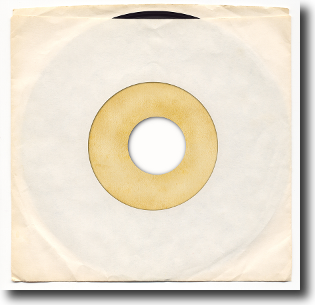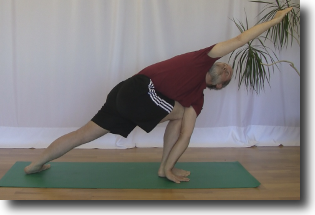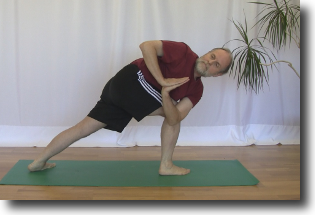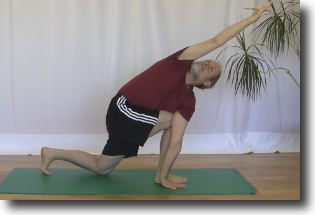“Let’s twist again like we did last Summer!” The line for an old popular song was playing in the back of Alice’s mind while she attempted to twist a little further in Parivrtta Parsvakonasana.
“I have never twisted like this before. Not even last summer like that song keeps saying.” thought Alice “I wonder what has changed or is it just lots of practice?
“Look, my shoulder is almost on my knee and my shoulders are getting closer and closer to being one above the other. Pretty soon now I will be ready to start working on the next stage of this twist.”
What is Parivrtta Parsvakonasana
Parivrtta Parsvakonasana is the Sanskrit name of a standing twist pose. The name translates as “revolved side angle pose”
The “revolved” part of the name is the twisting part that Alice is talking about. The “Side Angle” part of the name describes what is going on with the legs in the pose. You have your legs in a lunge about a leg length and a half apart with the back leg straight and the front leg bent at the knee and your hips are lowered towards the floor.
This pose strengthens and stretches the legs, knees, and ankles as well as the the groins, spine, chest, lungs and shoulders.
The twisting of the pose stimulates abdominal organs which will help to improve digestion and elimination. It also increases balance and stamina.
Parivrtta Parsvakonasana is one of the poses in the Standing Series of Ashtanga Yoga. It appears near the beginning of the series.
Let’s have a look at how to do this pose in detail and then we will see how Alice is developing the twist in her torso so she will be able to “Twist again, like we did last Summer”.
How to do Parivrtta Parsvakonasana
“Heeee, and round and round and up and down we go again!” Like the line in the song that is playing in Alice’s head you do a lot of twisting but you hold still rather than “going round and round and up and down”
You start in Tadasana with your feet together and your arms at your side and your gaze is straight ahead.
From here you inhale and step out to the right about a leg length and a half. Your back leg is straight and the foot is turned about 45 degrees towards your front foot. Your front leg is bent at the knee and your foot is pointing at the end of the mat. The heel of your front foot is in line with the heel of your back foot, your front knee is over your ankle and your hips are descending towards the floor.
Once you have your legs set up you start working on the twist.
Turn your torso to the right and bring your left shoulder down on the outside of your right knee. Place your hand on the floor beside your right foot and bring your shoulders one above the other.
Once you have your torso in position raise your right arm and point about halfway up the wall. There should be a straight line from your wrist through your shoulder, hip and ankle.
Finally turn your head bringing your chin towards your right arm and gaze towards the fingers of your right hand. Hold here for several breaths and then repeat the pose on the other side.
Where is the challenge in this pose
The challenge in this pose is the twisting. Getting the shoulder to the knee and the hand to the floor beside your foot is very difficult for most people.
The muscles in the back need to lengthen and the spine needs to get more flexible before you can twist far enough to complete the pose.
How to develop the twist
Typically you will go through three stages in this pose as you develop the rotation in your torso.
- palms together
- back knee to the floor
- back knee lifted
1 – Palms together
As you twist your torso to the left bring your palms together with your elbows pointing up and down and your fingers pointing towards your face.
Your hands will be next to your chest and your left arm will be pressing against your right knee. Bring your gaze towards your palms in this variation of the pose.
Pushing your left arm against your right knee and pushing your right shoulder back by pushing your palms together will help to lengthen the muscles in your back and you will start to twist some more.
Once your left shoulder is on your right knee and your shoulders are one above the other it is time to move on to the next stage.
2 – Back knee to the floor
In this stage you drop your back knee to the floor and put your right hand on your right thigh. Push into your thigh with your right hand to help your torso to twist to the right as your lower your left shoulder down beside your right knee. Now you bring your left hand to the floor beside your right foot.
You continue to use your right hand against your right thigh to help your torso to twist further until your shoulders are one above the other. At this point your bring your right arm up like you do in the full pose.
Once your hand is resting firmly on the floor beside your right foot and your shoulders are comfortably one above the other it is time to move on to the final stage of the twist.
3 – Back knee off of the floor
Now that you have your left hand firmly on the floor beside your right foot and your shoulders are one above the other, lift your back knee off of the ground, turn the heel of your back foot to the centre of the mat and bring your foot down flat to the mat. Eventually your back leg will be straight and your back foot will be flat to the floor.
Now bring your right arm up overhead and point about half way up the wall. Turn your head towards your upper arm and gaze towards the fingers of your upper arm. You will have a straight line from your wrist through your shoulders and hips to your ankle.
You now have fully developed the twist in your torso that is required to complete this pose.
But my hand comes off of the floor when I lift my back knee
There are two actions that you can take when this happens.
— If your hand is only lifting up a small amount you can put a block or foam under your left hand. This additional support will permit you to get pressure back in your left hand and help support you in the pose as you continue to develop the twist in your spine.
— Alternately you can let your left arm and shoulder come in front of your right knee. This will let your shoulder move back to the left a little bit, reducing the amount of twist in your spine and your hand will be able to come back to the floor.
Both of these actions are temporary. You should continue to work on increasing the twisting action in your torso so that your left hand is resting on the floor and your shoulders are one above the other with your left shoulder on the outside of your right knee.
Summary
“‘Lets twist again like we did last Summer. Up and down and round and round.’” The song is still playing in Alice’s head.
“Maybe if I keep at this twisting in Parivrtta Parsvakonasana my back won’t hurt so much when I try the twist again on the dance floor this Summer.” thinks Alice.
“The last time I tried to twist like the song says I hurt the muscles in my back. Maybe this summer it will be different and I will have to thank all the practice twisting in Parivrtta Parsvakonasana for strengthening and lengthening my back muscles.”
Next Step
There are many benefits to a regular yoga practice. Being able to dance better is just one of them.
Bring your dance partner to yoga class with you the next time and you will both have a good time on the dance floor next Summer.







